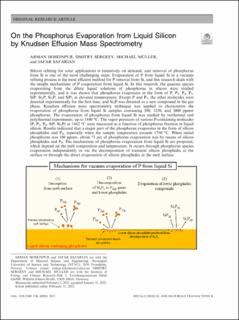| dc.description.abstract | Silicon refining for solar applications is intensively on demand, and removal of phosphorus from Si is one of the most challenging steps. Evaporation of P from liquid Si in a vacuum refining process is the most efficient method for P removal from Si, and this research deals with the insight mechanisms of P evaporation from liquid Si. In this research, the gaseous species evaporating from the dilute liquid solutions of phosphorus in silicon were studied experimentally, and it was shown that phosphorus evaporates in the form of P, P2, P4, P3, SiP, Si2P, Si3P, and SiP2 at elevated temperatures. Except P and P2, the other molecules were detected experimentally for the first time, and Si3P was detected as a new compound in the gas phase. Knudsen effusion mass spectrometry technique was applied to characterize the evaporation of phosphorus from liquid Si samples containing 100, 1250, and 3000 ppmw phosphorus. The evaporation of phosphorus from liquid Si was studied by isothermal and polythermal experiments, up to 1840 °C. The vapor pressures of various P-containing molecules (P, P2, P4, SiP, Si2P) at 1442 °C were measured as a function of phosphorus fraction in liquid silicon. Results indicated that a major part of the phosphorus evaporates in the form of silicon phosphides and P4, especially when the sample temperature exceeds 1750 °C. When initial phosphorus was 100 ppmw, about 71 pct of phosphorus evaporation was by means of silicon phosphides and P4. The mechanisms of phosphorus evaporation from liquid Si are proposed, which depend on the melt composition and temperature. It occurs through phosphorus species evaporation independently or via the decomposition of transient silicon phosphides at the surface or through the direct evaporation of silicon phosphides at the melt surface. | en_US |

